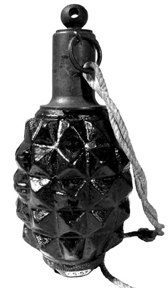|
Type- Fragmentation
Weight- Approx 1 lb
Igniter- Percussion/delay
The Lancaster
grenade was designed in 1917 by James H. Lancaster of New York.
It is one of many that were designed and offered to the US Army during
the First World War. There were a
number manufactured as evidenced by surviving examples.
It was not however adopted for service.
The main body is made of cast iron with
pyramid shaped fragments on the outside and on the inside four rows of larger
fragments. Large holes in the ends
of the body are threaded to accept the filling plug and the igniter mechanism.
The filling plug is knurled on the outside edge and has two deep “V”
shaped grooves on the bottom forming a cross that would allow the filling plug
to break into more fragments. The
igniter mechanism screws into the other hole.
A detonator holder containing the detonator and delay fuze extends into
the centre of the body. The igniter
mechanism contains a primer located at the top of the delay fuze, striker,
firing spring, and firing plug at the top.
A cord is attached to the firing plug through the ball at the top.
A safety pin fits through the body of the igniter mechanism and through a
hole in the firing plug holding it in place.
The remainder of the body is filled with explosive to provide the
bursting charge.
When the grenade is to be
thrown, the cord is placed over the wrist of the throwing hand and the safety
pin removed. At this point the
grenade is held safe by the firing plug.
When thrown and upon the grenade reaching the end of the cord, the firing
plug is pulled out releasing the firing spring which pushes the striker down
onto the primer. The primer fires
and ignites the delay fuze. When
the delay fuze burns down to the detonator it causes the grenade to explode.
The objective of this
grenade was to make the grenade safer for the user.
It was noted that if the thrower was shot or stumbled while throwing the
grenade, it would drop to the length of the cord, the force of dropping not
being enough to withdraw the firing plug thus the grenade would not explode
amongst friendly troops and could be picked up and thrown in complete safety.
The design drawings
indicated that a hollow throwing handle could be attached to the igniter
mechanism to increase range, the grenade operating in the normal manner.
It also shows an auxiliary explosive container that could be attached to
increase the explosive charge although the manner of attachment is somewhat
unclear.
The grenade was not adopted
for service although it does appear to have been manufactured at least in small
numbers for testing.
|
